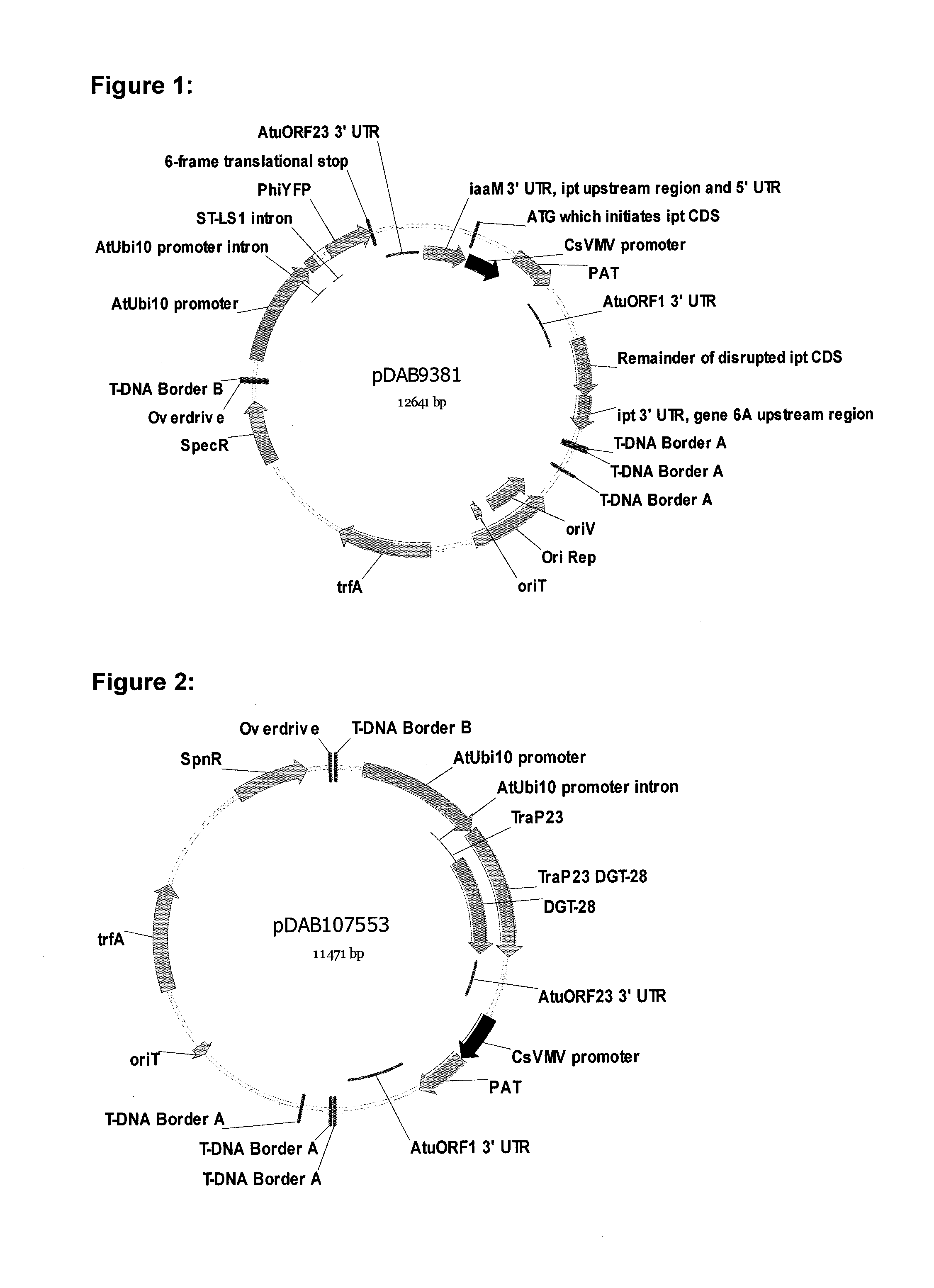Soybean transformation for efficient and high-throughput transgenic event production
a transgenic event and soybean technology, applied in the field of plant breeding, can solve the problems of high variability, difficult to achieve efficient transformation and regeneration of soybean explants, and difficult to achieve efficient transgenic event production,
- Summary
- Abstract
- Description
- Claims
- Application Information
AI Technical Summary
Benefits of technology
Problems solved by technology
Method used
Image
Examples
example 1
Vector Construction
[0112]A single binary vector labeled as pDAB9381 (FIG. 1) was constructed using art-recognized procedures. pDAB9381 contains two Plant Transcription Units (PTUs). The first PTU (SEQ ID NO:1) consists of the Arabidopsis thaliana ubiquitin-10 promoter (AtUbi10 promoter; Callis et al., 1990) which drives the yellow fluorescence protein coding sequence (PhiYFP; Shagin et al., 2004) that contains an intron isolated from the Solanum tuberosum, light specific tissue inducible LS-1 gene (ST-LS1 intron; Genbank Acc No. X04753), and is terminated by the Agrobacterium tumefaciens open reading frame-23 3′ untranslated region (AtuORF23 3′UTR; Gelvin et al., 1987). The second PTU (SEQ ID NO:2) was cloned within the isopentenyltransferase coding sequence (ipt CDS; Genbank Acc No. X00639.1), consisting of the Cassava Vein Mosaic Virus promoter (CsVMV promoter; Verdaguer et al., 1996) which is used to drive the phosphinothricin acetyl transferase coding sequence (PAT; Wohlleben et...
example 2
Agrobacterium-Mediated Transformation of Soybean Using Split-Seeds Comprising a Portion of an Embryonic Axis
[0114]Seed Preparation.
[0115]A novel Agrobacterium-mediated soybean transformation protocol was developed. Mature soybean (Glycine max) cv. Maverick seeds were sterilized overnight with chlorine gas for sixteen hours. Following sterilization with chlorine gas, the seeds were placed in an open container in a LAMINAR™ flow hood to dispel the chlorine gas. Next, the sterilized seeds were imbibed with sterile H2O for sixteen hours in the dark using a black box at 24° C.
[0116]Preparation of Split-Seed Soybeans.
[0117]The split soybean seed comprising a portion of an embryonic axis protocol required preparation of soybean seed material which was cut longitudinally, using a #10 blade affixed to a scalpel, along the hilum of the seed to separate and remove the seed coat, and to split the seed into two cotyledon sections. Careful attention was made to partially remove the embryonic axis...
example 3
Confirmation of Transgenic Events Via Agrobacterium-Mediated Transformation of Split Soybean Seed Comprising a Portion of the Embryonic Axis
[0130]Transgenic soybean events containing a T-strand insert comprised of the YFP and PAT PTUs were produced using the novel Agrobacterium-mediated transformation of split soybean seeds comprising a portion of the embryonic axis transformation method described in Example 2.
[0131]A total of six independent transformation experiments, consisting of three experiments each for the EHA101 and EHA105 strains, were completed using the novel method. The T0 soybean putative transgenic events which were grown in the greenhouse were further confirmed by TAQMAN™ and PCR analysis of the PAT and YFP PTUs, respectively. The results of the average transformation frequency are presented in Table 1 and Table 2. Overall, the novel Agrobacterium-mediated transformation of split soybean seeds comprising a portion of the embryonic axis transformation method resulted ...
PUM
| Property | Measurement | Unit |
|---|---|---|
| Electrical resistance | aaaaa | aaaaa |
| Fluorescence | aaaaa | aaaaa |
Abstract
Description
Claims
Application Information
 Login to View More
Login to View More - R&D
- Intellectual Property
- Life Sciences
- Materials
- Tech Scout
- Unparalleled Data Quality
- Higher Quality Content
- 60% Fewer Hallucinations
Browse by: Latest US Patents, China's latest patents, Technical Efficacy Thesaurus, Application Domain, Technology Topic, Popular Technical Reports.
© 2025 PatSnap. All rights reserved.Legal|Privacy policy|Modern Slavery Act Transparency Statement|Sitemap|About US| Contact US: help@patsnap.com


